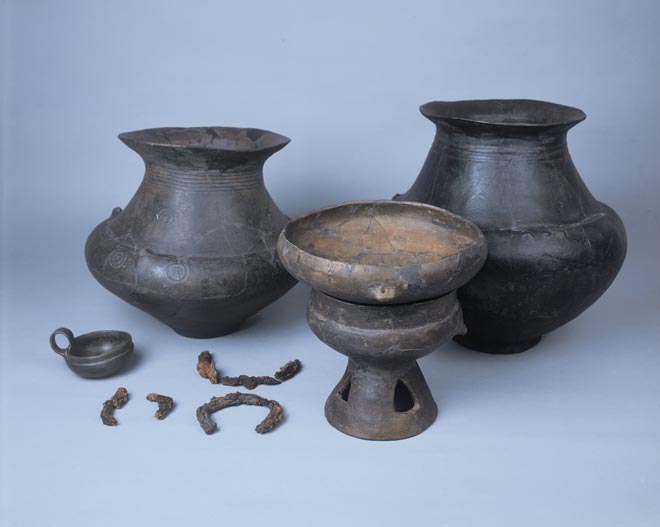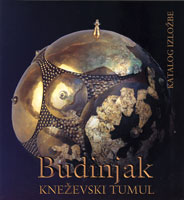Budinjak – a Princely Tumulus
Exhibition concept: Želimir Škoberne
Exhibition design: Željko Kovačić
Poster design: Miljenko Gregl
 The aim of this exhibition was to introduce the public to the importance of the material found in princely tumulus 139, and particularly the grave of the warrior prince. We wanted to show the results of the entire process of research, from the very beginnings of excavating the burial mound, through individual phases of the conservation and restoration of the discovered artifacts both in Croatia and in the laboratories of the Römisch-Germanisches Zentralmuseum in Mainz, and the production of replicas of the inventory of the princely warrior grave, to the final scientific analysis and interpretation.
The aim of this exhibition was to introduce the public to the importance of the material found in princely tumulus 139, and particularly the grave of the warrior prince. We wanted to show the results of the entire process of research, from the very beginnings of excavating the burial mound, through individual phases of the conservation and restoration of the discovered artifacts both in Croatia and in the laboratories of the Römisch-Germanisches Zentralmuseum in Mainz, and the production of replicas of the inventory of the princely warrior grave, to the final scientific analysis and interpretation.
The scientific investigation of the bowl-shaped helmets from the princely warrior graves in tumulus 139 and tumulus 3 has enabled insight into the very complicated technique of manufacturing such helmets, which has further offered new possibilities of the classification and more precise dating of this group of the earliest Hallstatt period helmets.
The village of Budinjak is located in the central section of the Žumberak Mountains. Its height is 740 meters above sea level, near the most elevated point on the road through these heights linking Zagreb with the towns of Ozalj and Karlovac. A plateau extends to the east of the village (Budinačko polje or Budinjak Plain), adjacent to a road leading south to the villages of Dane and Kordići. Soon after starting to survey this plateau, we discovered a large cemetery of grave mounds or tumuli, with a hillfort settlement directly above it.
The tumulus cemetery is located below the hillfort on the plateau to the north, extending over an area of around 60,000 m2. Geodesic mapping revealed 141 tumuli. The tumuli are circular and of various sizes, with diameters from 5 to 20 meters and heights from 50 cm to 2.2 meters.
The grave goods found at the Budinjak cemetery belong to the southeastern Alpine European Hallstatt tradition. They consist of fragments or entirely preserved examples of bronze and iron decorative pins, brooches, belt buckles, bronze and iron bracelets, bronze anklets, iron torcs, glass and amber necklaces, crescent razors, iron and bronze spearheads, knives, axes, etc., as well as the standard pottery material. The pottery vessels exhibit similarities to the Hallstatt circle of the southeastern Alpine region in terms of production.


In the summer of 1993, princely tumulus 3 was excavated in Budinjak Plain. It contained 10 graves, one with a bowl-shaped helmet. Thanks to such a valuable discovery and the financial support of the Office for Culture of the city of Zagreb, in the autumn of 1993, the excavation of tumulus 139 began. Excavation was interrupted soon after because of poor weather conditions, but was continued in the summer of 1994, when the tumulus was completely excavated. The tumulus was located on the northwestern edge of the burial mound cemetery. The diameter measured 19 meters, with a height of 2 meters. The tumulus contained seven burials.
When tumulus 139 is considered in entirety in its final form, it can be concluded that it contained one double grave – princely grave 6 (male and female), and another six graves, three of which were female (graves 3, 5, and 7), and three male (graves 1, 4, and possibly 2). In terms of absolute chronology, all of the burials in the tumulus can be dated to the 8th and the beginning of the 7th centuries BC.
Želimir Škoberne
Pictures from the exhibition


 Exhibition catalogue
Exhibition catalogue
Škoberne, Želimir. Budinjak - a princely tumulus.
Zagreb : Zagreb City Museum, 1999
Related reviews
Glogović, Dunja. Book Reviews : Želimir Škoberne: Budinjak : Princely Tumulus. // Arheološki vestnik, 52(2001), p. 402-403.

